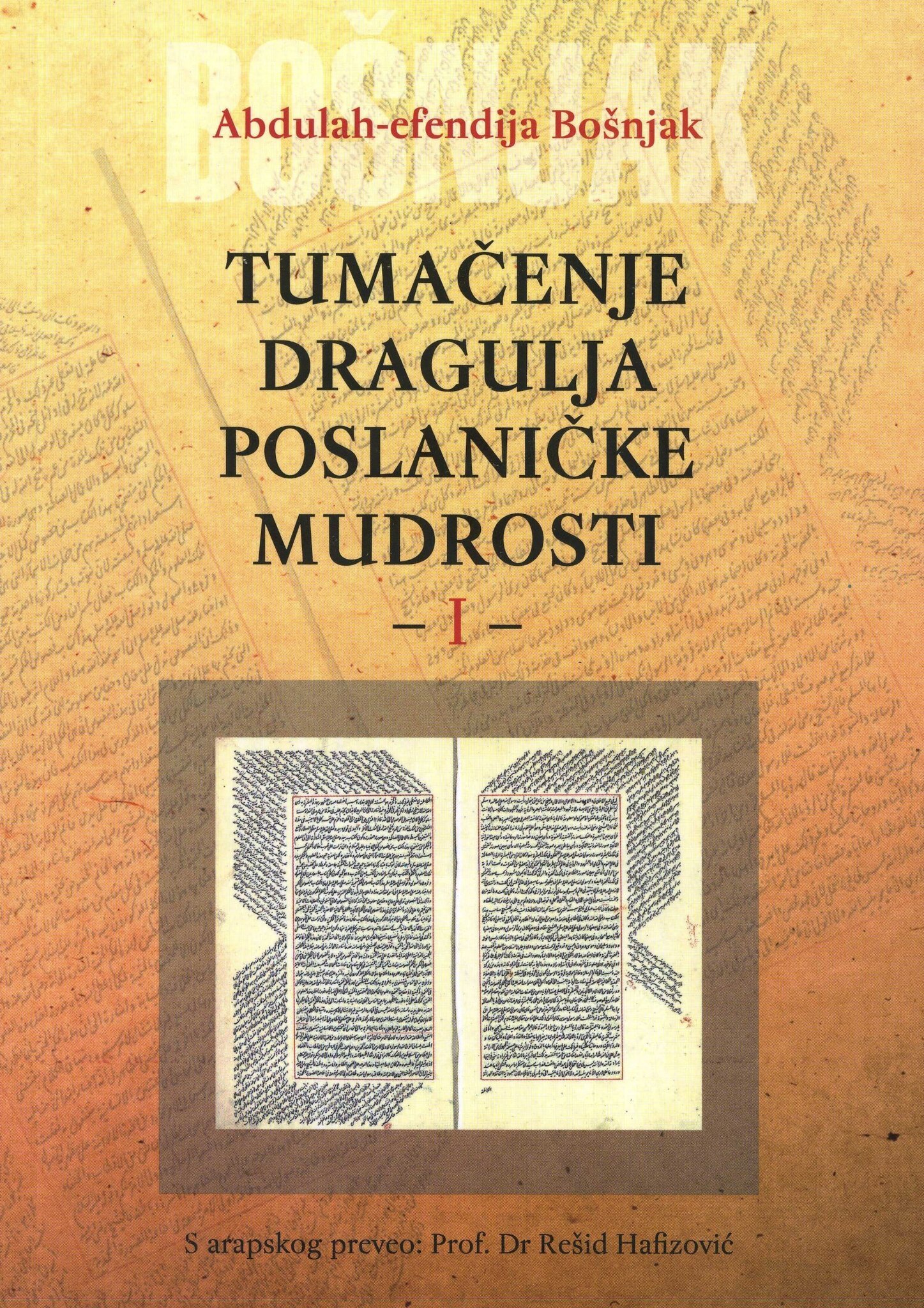
ABDULLAH BOŠNJAK
Author: Shaykh, assist. prof. Edin Urjan Kukavica, PhD, Faculty of Educational Sciences of University of Sarajevo, shaykh of Naqshbandi and Rifa’i tariqas

Writing about this great Bosniak, Nusret Čolo says: “Abdullah b. Muhammed el-Bosnevi (Bošnjak), known under pen names Šarihul-fusus (Commentator of Fusus), Abdi and Abdullah Bosnevi was a mutesavvif, alim, poet of the 17th century. He was a follower of the Bairami-Melamii tariqa, a great expert in and commentator of Ibn al-Arabi’s (k.s.) works and an enthusiastic supporter of his Sufi school.”
Shaykh Abdullah (k.s.) was born in Bosnia, but there are no reliable data about the place and time. He acquired primary and secondary education in Bosnia, and completed university studies in Istanbul, where he joined a tariqa society of the well-known Halwati shaykh Abdul-Mejid Sivasi (k.s.). After some time, in Bursa, he joined shaykh Hasan Kabaduz, who strongly influenced his spiritual advancement. Until the death of shaykh Hasan Kabaduz (passed away in 1010 Hijri year/1601–02 A.D.) he lived in Bursa, and then moved to Konya, where he died in 1054 Hijri year/1644 A.D. His academic oeuvre is diverse, since Abdullah Bošnjak wrote about almost all the tasawwuf topics of the time.
Muhammed Nazmi-effendi describes an event from Abdullah’s life: “One day, Abdullah Bosnevi came to Ejjub to visit Abdul-Mejid Sivasi (k.s.); he was very shy and did not dare to enter his premises and he hid behind the corner of the mosque. When Abdul-Mejid saw it, he ordered Sertarik-dede to bring him in. When he was brought before Abdul-Mejid, Abdullah Bošnjak expressed the desire to be accepted into the shaykh’s group, which the shaykh gladly accepted.” Later on, Abdullah Bošnjak wrote the šarh (commentary) Cilau l-uyuni fi šerhi kasideti 'abdi l-Mecidi es-Sivasi (Sharpening vision in commenting on a qasida by Abdul-Mejida es-Sivasi), which reveals strong spiritual ties between the two Sufis.
During the reign of sultan Murat IV, a strong campaign began against the tariqa led by Kadi-zade Mehmed-effendi, the main vaiz (preacher) in the Hagia Sophiy Mosque, whose khutbahs (sermons) left a deep impression on people. Kadi-zade and the like-minded people were particularly against devran dhikr (“dervish whirling dance”), Sama or Mawlawiya (dance) and categorically demanded that tekkes be closed. All these created an unbearable anti-dervish climate in Istanbul, which most likely affected Abdullah Bošnjak’s decision to move to Bursa and join shaykh Hasan Kabaduz (k.s.). In one magmua (notebook) held in the Suleymaniye Library in Istanbul one can find two letters sent by shaykh Hasan Kabaduz to two of his khalifs – Abdullah Bošnjak and Husein Lamekani (k.s.). In these letters he brings to their attention some important issues in their spiritual advancement. Until the death of shaykh Hasan Kabaduz, who, according to most researchers, authorized to join the order, shaykh Abdullah Bošnjak lived in Bosnia, in service and in spiritual education. There are no reliable data on where Abdullah Bošnjak resided after shaykh Hasan’s death and what he was involved in though, based on his works and long trips it seems that he decided not to stay anywhere permanently but rather to travel all the time. In his work Sicilli Osmani, Sureyya Mehmed-pasha also writes that Abdullah was a traveler.
In his sequel to the comprehensive work Eš-Šekaikun-numanijje, Ata’i writes as follows: “Hala hayatta olan Fusus šarihi Abdi Efendi, Huseyin Lamekani'nin halifesidirˮ, which directly indicated the conclusion that after the death of shaykh Hasan Kabaduz, Abdullah Bošnjak completed his sejri suluk (spiritual journey) with Husein Lamekani (died in 1626). According to some historians and biographers, in 1636 Abdullah Bošnjak went to hajj via Cairo. After the hajj, Abudllah lived in Damascus (Sham), in the immediate vicinity of Sheihul-Akbar’s tomb and committed himself to studying his works. Later on, he went to Konya to visit Hazreti Mevlana Jalaluddin Rumi (k.s.) and Sadruddin Konjevi (k.s.); according to Husejn Vassaf, he stayed there for eight years in Mevlevi Asitata, until his death (in 1054 Hijri year/1644 A.D.). According to his personal vasijet (testament), he was buried next to Sadruddin Konjevi, who was also a pupil of Ibn Arabi and a commentator of the famous work Fususul-hikem (Pearls of Wisdom). The following tarih (chronogram) is inscribed on his tomb: This is the tomb of poor Allah’s traveler on earth Abdullah Bosnevi, Rumi Bayrami.
His academic oeuvre is thematically diverse, since Abdullah Bošnjak, as a theoretical representative of Ibn al-Arabi’s Sufi school wrote about almost all the tasawwuf topics which were important at the time. In his treatises Abdullah Bošnjak explained and commented upon everything that preoccupied him as a Sufi and a shaykh, so that his life oeuvre is an integral image and an overview of issues which were interesting for Sufis of his time, as well as indications of tendencies and theoretic-thematic solutions in the present tasawwuf studies. In his works Abdullah Bošnjak discussed Allah as the Absolute Being, Allah as the Maker of the universe, the very phenomenon of creation, the man and his spiritual nature as well as his place and role in this world, relations between the human soul and Supreme Allah, the primordial habitat of the soul as the “idea” in Divine omniscience and its ascent and return to this condition before the emergence of material existence, the tariqa and, finally, the life of Sufis. His best-known work is the commentary on Fususul-hikem entitled Tecelliyat 'araisin-nusus fi menassati hikemil-fususi (Manifested considerations of chaste maidens of holy texts in clear statements of the wisdom of Fusus). Besides the text of the commentary Abdullah Bošnjak wrote an extensive introduction with twelve topical headings, where he presented all the basic issues of Sufi theory and practice. In this text he proved to be original, synthesizing the entire Sufi theory and providing his stamp and his view of it. The commentary of shaykh Abdullah was printed in Istanbul in 1290 Hijri year/1873 A.D. in two volumes, on 1150 pages, and the autograph is held in the Suleymaniye Library, Shahid Ali Pasha Department, no. 1244.
